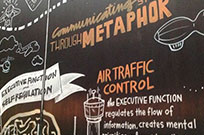Page Content
Core story of brain development theme of symposium
Knowledge of early brain development could help educators, parents, families and communities discuss how social–emotional and cognitive skill–building are interconnected and how school communities might support further the development of resilient, healthy children and youth.

In October, the Norlien Foundation, through the Alberta Family Wellness Initiative (AFWI), set out to educate and support Alberta’s science, policy and practice communities with research into and conversations about how our brains are built. “Accelerating Innovation: Telling the Brain Story to Inspire Action” was an invitational symposium featuring guest speakers from the world’s most advanced brain research institutes. Delegates included physicians, teachers, judges, academics and senior government policy makers who participated in discussions about the latest in brain research. The symposium’s goal was to empower diverse communities of practice to form Innovation Teams that would create real-world projects on early childhood development, good mental health and fighting addiction.
Although neuroscience and brain research can be a complex field, the symposium made the latest research easily understandable to the broad range of people in attendance. Imagine a judge, a physician and a teacher using metaphors like a tennis match (serving and returning human interactions) to describe how genes and human experiences together build brains, or discussing how toxic stress interferes with the “air traffic control” systems of the brain that regulate our attention, actions, emotions, and working and long-term memory.
Premier Alison Redford brought greetings from the government and Minister of Human Services David Hancock discussed proposals put forward by the symposium’s Innovation Teams on how to collectively influence Alberta’s policies and practices.
Teachers at the symposium learned a great deal, especially with respect to major findings from the research on early brain development. The following seven key ingredients for healthy brain development, from the National Scientific Council on the Developing Child, are worth noting:
- Child development is the foundation of prosperous communities.
- Brains are built over time, from the bottom up (skill begets skill).
- Genes and experiences together build brains (serve-and-return relationships).
- Cognitive, social and emotional developments are inextricably intertwined.
- Toxic stress damages brain architecture.
- Resilience is not internal character strength but, rather, is built through the combined impact of genes and childhood experiences.
- For many functions, the brain’s ability to change decreases over time (cost-effectiveness factor), yet not all our abilities are affected.
Paula Tyler, president of the Norlien Foundation and executive director of AFWI, stated in a magazine article: “It’s important that these conversations be informed, current and evidence-based. By knowing more about how the brain develops—and how it can change—we will be better able to help people reach their potential and aspirations. Healthy brains literally mean healthy communities.”
To learn more about the work of the Alberta Family Wellness Initiative, or to access free resources, visit www.albertafamilywellness.org. ❚
